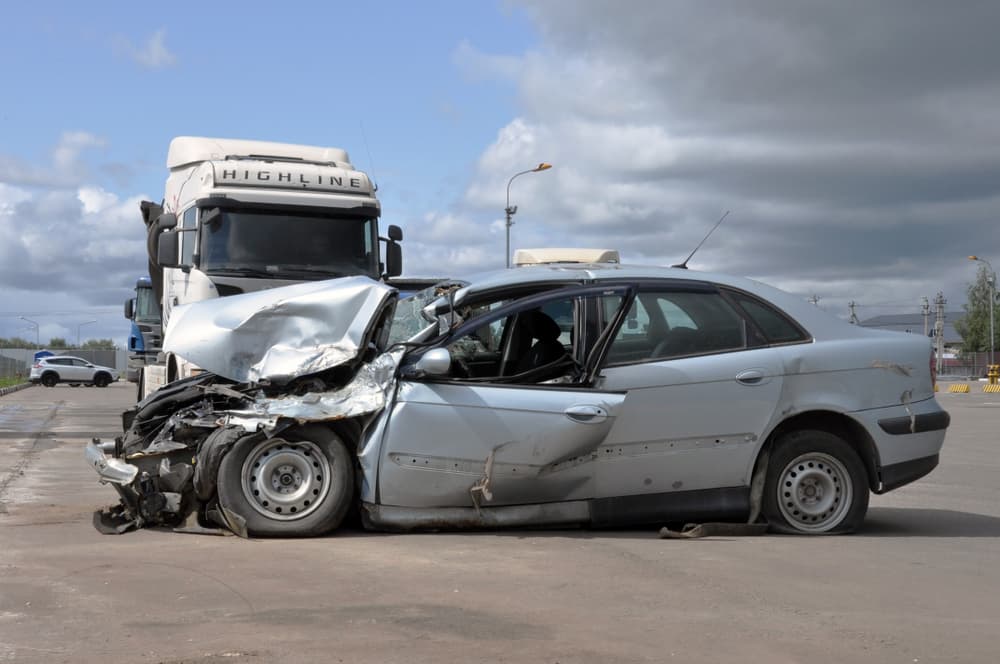Truck T-bone accidents are among the most dangerous and destructive collisions you can experience on the roadways. These accidents occur when the front of a truck strikes the side of another vehicle, creating a shape resembling the letter T.
Due to the sheer size and weight of trucks, T-bone accidents can lead to catastrophic injuries, extensive property damage, and, unfortunately, fatalities.
In this blog, we will discuss the common causes of truck T-bone accidents, the potential liability they involve, and the necessary steps to take following such a collision to protect your rights and secure the compensation you deserve.
If you or a loved one have been involved in a truck T-bone accident, reach out to an experienced truck accident lawyer who can provide the legal guidance and support needed during this challenging time.
Establishing Negligence
When pursuing a personal injury claim in a truck T-bone accident, your attorney will need to establish negligence on the part of the at-fault party. The elements to prove negligence include a duty of care, breach of that duty, causation, and damages. You must identify the party at fault for your injuries to pursue a negligence claim.

The following potential parties can face liability for the accident:
- Truck driver: The court may hold the driver responsible if their actions, such as speeding, distracted driving, or impaired driving, led to the crash.
- Trucking company: The company that owns the truck or employs the driver may face liability if they failed to train or supervise the driver properly, violated federal or state safety regulations, or engaged in negligent hiring practices.
- Third parties: Other parties, such as those responsible for the improper loading of cargo, may also face liability if their actions contributed to the accident.
You must prove negligence in a personal injury claim, as it establishes the at-fault party's responsibility for the victim's damages and losses. Your attorney will gather evidence supporting the claim, such as police reports, witness statements, and expert testimony, to demonstrate the at-fault party's negligence leading up to the accident.
Duty of Care
A key component of any negligence case is establishing that the at-fault party owed the victim a duty of care. In the context of truck driving, a duty of care is that all drivers exercise reasonable care to avoid causing harm to others on the road.
Like all drivers, truck drivers need to adhere to a standard of care that includes obeying traffic laws, being attentive to road conditions, and maintaining their vehicles in a safe and operational state.
Examples of duty of care in truck driving include maintaining a safe following distance, yielding to other vehicles when necessary, obeying speed limits, and properly securing cargo.
Breach of Duty
To succeed in a personal injury claim, your attorney must prove that the at-fault party breached their duty of care.
This breach can occur in many ways and, in the context of truck T-bone accidents, includes:
- Failing to yield the right of way to another vehicle at an intersection.
- Running a red light or stop sign.
- Operating the truck while under the influence of drugs or alcohol.
- Distracted driving, such as texting or eating while operating the vehicle.
Your attorney will work to gather evidence to show the breach of duty, such as expert testimony, witness statements, and documentation of the at-fault party’s actions leading up to the crash.
Causation
Once your attorney shows a breach of duty, they must demonstrate causation or a direct link between the breach of duty and the accident. This vital step can prove negligence in a personal injury case.
Establishing a Direct Link Between the Breach of Duty and the Accident
Proving causation means showing that, but for the at-fault party's breach of duty, the accident would not have occurred. Your attorney must present evidence that directly connects the breach to the injuries and damages you sustained in the truck T-bone accident.
Methods of Proving Causation
Your attorney may several methods use to prove causation, such as:
- Accident reconstruction: Expert testimony from an accident reconstruction specialist can establish the sequence of events leading up to the collision and how the at-fault party's actions directly caused the accident.
- Surveillance footage: Video evidence from nearby traffic cameras or business security systems can demonstrate the at-fault party's actions and how they contributed to the T-bone accident.
- Witness testimony: Statements from individuals who witnessed the accident can provide crucial information about the events surrounding the crash and establish causation.
Recoverable Damages After a Truck T-Bone Accident
In a personal injury case, your attorney must prove the extent of the damages you suffered because of the truck T-bone accident.
Damages can fit into several categories:
Types of Damages Available in Truck T-Bone Accidents
Damages can go into three categories: economic, non-economic, and punitive.
Economic damages refer to losses that carry a specific dollar amount.
These typically include:
- Medical costs: These comprise hospital bills, rehabilitation costs, and ongoing care relating to injuries the relevant parties sustained in the accident.
- Property damage: This entails the cost of repairing or replacing your vehicle or any other personal property the at-fault party damaged in the collision.
- Lost income: If the accident resulted in missed work, you can claim compensation for lost income. You may request compensation for reduced earning capacity if your injuries force you to work less, take a lower-paying position, or retire early. When injuries cause permanent damage or disability and you can no longer work, you can recover the deficit in pay you will experience from the time of your injury through your expected retirement age.
- Additional costs: These consist of any other costs necessary for your injury recovery or lifestyle changes. This can include the cost of replacement home services, such as cooking, cleaning, and home maintenance, and home modifications, such as ramps, widened doorways, or eclectic lifts.
Non-economic damages have no specific dollar amount but are subjective to the victim.
These losses include the following:
- Emotional distress: The accident may have caused emotional trauma, such as anxiety, depression, or post-traumatic stress disorder, for which you may receive compensation.
- Loss of quality of life: You can recover compensation for changes to your lifestyle if your injury causes you to give up hobbies or be unable to spend time on certain activities as you did previously.
- Loss of consortium: You may receive compensation if you can no longer enjoy a physical relationship with your partner.
- Pain and suffering: You can recover compensation for the pain and suffering experienced during the accident and recovery.
The court may award punitive damages at its discretion. These damages punish the at-fault party for particularly egregious actions and deter similar behavior.
Importance of Proving Damages in Personal Injury Cases
You must prove damages to secure compensation for your injuries and losses. Your attorney will gather medical records, expert testimony, and other documentation to demonstrate your damages and build a strong case for full and fair compensation.
Trucking Regulations and How They May Affect Liability
When pursuing a personal injury claim in a truck T-bone accident, it's essential to understand the federal and state regulations governing the trucking industry. These regulations ensure all road users' safety and can play a critical role in establishing negligence in your case.
Overview of Federal and State Trucking Regulations
The Federal Motor Carrier Safety Administration enforces numerous regulations that govern commercial trucking. These rules cover various aspects of trucking, including driver qualifications, hours of service, vehicle maintenance, and cargo securement. States may have their own set of trucking regulations that supplement federal rules.
Regulation Violations As Evidence of Negligence
Violations of trucking regulations can support a claim of negligence against the at-fault party in a personal injury case.
Regulation violations that can serve as evidence of a breach of the duty to drive responsibly and operate a safe vehicle include:
- Hours of service violations, which may indicate driver fatigue.
- Failure to maintain the truck in a safe operating condition, which may relate to the reason for the accident.
- Insufficient driver training or supervision, which may indicate a lack of knowledge about safe truck driving.
Vicarious Liability
In many truck T-bone accident cases, the principle of vicarious liability may be applicable, holding trucking companies responsible for the actions of their drivers.
Principle of Holding Trucking Companies Liable for Driver Actions
Vicarious liability refers to the concept that the court can hold an employer accountable for the negligence of its employees, providing that the employee was acting within the scope of their employment. This means that if a truck driver's actions caused the T-bone accident, the trucking company may also face liability for damages.
Conditions for Establishing Vicarious Liability
To establish vicarious liability in a truck T-bone accident case, your attorney must demonstrate the following details:
- The truck driver was an employee of the trucking company at the time of the accident.
- The driver was acting within the scope of their employment when the accident occurred.
- The driver's actions were a direct cause of the accident and the resulting damages.
Preservation of Evidence
In a truck T-bone accident case, preserving evidence of the accident is crucial to establishing negligence and securing compensation.
Accurate and comprehensive evidence can significantly strengthen your personal injury claim. Prompt action to preserve evidence is critical, as some types of evidence, such as skid marks, vehicle damage, or witness memories, may go missing or deteriorate over time.
Types of Evidence Crucial for Establishing Negligence
Evidence essential to establishing negligence in a truck T-bone accident case includes:
- Photos or videos of the accident scene, vehicle damage, and injuries.
- Eyewitness statements and contact information.
- Accident reports that law enforcement or other parties file.
- Medical records documenting your injuries and treatment.
- Documentation of lost income and other damages.
Your lawyer can work on your behalf to collect, document, and preserve evidence relating to your truck T-bone accident.
Statute of Limitations
After a truck T-bone accident, it's crucial to understand the statute of limitations or the time frame within which you must file a personal injury claim.
Time Frame for Filing Personal Injury Claims
Each state has its statute of limitations for personal injury cases, which typically ranges from one to six years from the date of the accident. Failure to file a claim within the appropriate time frame can result in losing your right to seek compensation.
Importance of Understanding the Statute of Limitations
Understanding the statute of limitations is essential to ensure you file your personal injury claim on time and preserve your rights. Consulting with an experienced personal injury attorney as soon as possible after a truck T-bone accident can ensure you take the necessary steps to protect your legal rights and secure compensation.
Contact a Truck T-Bone Accident Attorney to Protect Your Rights

Understanding the legal aspects of truck T-bone accidents is crucial for protecting your rights and securing fair compensation. Contact an experienced personal injury attorney who can navigate the complex process of establishing negligence, proving damages, and examining compliance with relevant trucking regulations. By partnering with a skilled attorney, you increase your chances of achieving the best outcome for your case, enabling you to focus on your recovery and move forward with your life.